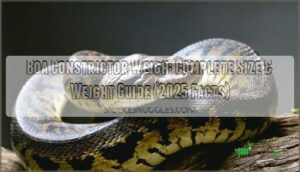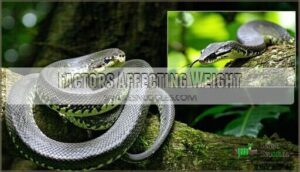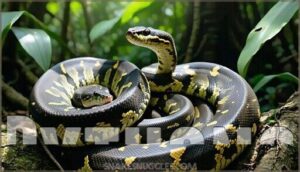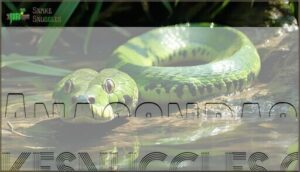This site is supported by our readers. We may earn a commission, at no cost to you, if you purchase through links.
 When you’re wondering how much a boa constrictor weigh, you’re looking at some serious muscle.
When you’re wondering how much a boa constrictor weigh, you’re looking at some serious muscle.
Adult boas typically tip the scales between 20-60 pounds, with females being the real heavyweights at nearly double the males’ size.
Think of it like this – males usually max out around 20-30 pounds and 8-10 feet, while females can easily hit 40-60 pounds and stretch over 12 feet.
That’s heavier than most dogs!
Captive boas often weigh more than wild ones due to consistent meals and less exercise, though this can sometimes backfire.
Age, diet, and living conditions all play key roles in determining their final weight, and there’s more to this weighty topic than meets the eye.
Table Of Contents
- Key Takeaways
- Boa Constrictor Weight Range
- Factors Affecting Weight
- Average Weight of Adult Boa Constrictors
- Weight of Juvenile Boa Constrictors
- Heaviest Recorded Boa Constrictor
- Comparison With Other Snakes
- Weight Changes Over Lifespan
- Impact of Captivity on Weight
- Health Implications of Weight
- Monitoring and Managing Weight in Captivity
- Frequently Asked Questions (FAQs)
- How much does a boa constrictor weigh?
- Do boa constrictors gain weight?
- Are boa constrictors bigger than male Boas?
- How long do boa constrictors live?
- What is a boa constrictor?
- Do boa constrictors have different subspecies?
- How much does a full grown boa constrictor weigh?
- Is a 4x2x2 big enough for a boa?
- How much does the largest boa weigh?
- Which is bigger, a python or a boa constrictor?
- Conclusion
Key Takeaways
- You’ll find adult boa constrictors weigh between 20-60 pounds, with females being nearly double the size of males – females typically reach 40-60 pounds while males max out around 20-30 pounds, which is their natural weight range.
- Your boa’s weight depends heavily on age, diet, and living conditions – juvenile boas start at just 2-4 ounces but can reach 1-3 pounds by their first birthday with proper feeding every 5-7 days.
- You need to monitor your captive boa’s weight carefully since overfeeding and limited exercise in captivity often leads to obesity, while wild boas stay leaner due to inconsistent food sources and more natural movement.
- You can expect your boa to continue gaining weight throughout its 20-30 year lifespan, with the most dramatic growth occurring between ages one and three when they can double their mass every few months, experiencing rapid growth.
Boa Constrictor Weight Range
When you’re wondering about boa constrictor weight, you’ll find these impressive serpents pack quite a range.
Most adult boas tip the scales between 45-100 pounds, with the sweet spot around 60 pounds for a healthy weight.
Most healthy adult boas hit that perfect 60-pound sweet spot – not too hefty, not too lean.
However, weight variation** runs deep in this species.
Wild vs captive boas show interesting differences.
Wild specimens often stay leaner due to inconsistent food sources, while captive boas can bulk up with regular feeding.
Subspecies weight also varies dramatically – Colombian boas typically weigh 20-30 pounds, while red-tailed boas range from 15-25 pounds.
Your average boa weight depends on several factors, but don’t expect a one-size-fits-all answer.
The ideal weight for your boa depends on its subspecies, age, and overall health.
Understanding boa size and weight patterns helps you gauge whether your snake’s hitting the right numbers for peak health.
Factors Affecting Weight
If you’re wondering why your boa constrictor’s weight seems to fluctuate like your own after the holidays, you’re not alone in this observation.
Several key factors influence how much your snake weighs, including their age, diet quality, and living conditions, which work together like pieces of a puzzle to determine their final size.
Age
Throughout your boa’s growth stages, age dramatically shapes weight gain.
Juvenile weight starts around 2-4 ounces, rapidly increasing until sexual maturity at 2-3 years when adult boa weight reaches 20-45 pounds.
The boa growth rate slows substantially after maturity, but lifespan weight continues climbing gradually.
Consider that python size varies markedly by species.
Understanding this age influence helps you track your snake’s healthy development milestones.
Diet
Your boa’s boa constrictor diet directly controls its weight gain.
Wild diet includes birds, mammals, and reptiles, with feeding frequency every 2-4 weeks.
Captive diet typically features rodents with more frequent meals. Some owners purchase boa constrictor rodents from online retailers.
Prey size should match your snake’s girth, while proper nutritional needs prevent obesity. A snake diet that’s too rich or frequent can pack on pounds faster than you’d expect.
Habitat
Your boa constrictor’s habitat directly shapes its weight through geographic variation and environmental factors.
Different regions offer varying prey availability and predator protection, affecting growth patterns substantially.
You can find resources for boa habitat products to optimize these conditions.
- Vegetation density determines shelter quality and hunting success rates
- Environmental conditions like humidity influence metabolism and feeding frequency
- Geographic distribution creates distinct weight variations across different habitat types
Average Weight of Adult Boa Constrictors
Most adult boa constrictors tip the scales between 60 to 70 pounds, though you’ll find considerable variation across different specimens.
Sexual dimorphism plays a key role here – females typically outweigh their male counterparts by 10-15 pounds due to their larger reproductive needs.
| Category | Male Weight | Female Weight |
|---|---|---|
| Average Range | 45-60 lbs | 60-80 lbs |
| Typical Adult Weight | 50-55 lbs | 65-70 lbs |
| Maximum Recorded | 85 lbs | 100+ lbs |
Weight fluctuation is completely normal – your boa’s weight can swing 5-10 pounds after a hefty meal.
Subspecies variation also matters; Colombian boas tend to be heftier than their Argentine cousins.
These measurement metrics help you gauge whether your snake’s maintaining a healthy weight range.
Weight of Juvenile Boa Constrictors
When you’re tracking a baby boa’s development, you’ll notice these serpents start surprisingly small.
Hatchling weight typically ranges from 60-100 grams, with newborns measuring around 14-20 inches long.
Your juvenile boa constrictor will experience rapid growth during its first year, potentially doubling in size within months.
Feeding frequency plays a vital role in early development.
You’ll need to offer appropriately-sized prey every 5-7 days to support their accelerated growth rate.
Juvenile growth patterns show these snakes can gain 2-4 ounces monthly during peak growing periods.
As detailed in a boa constrictor size chart, genetics and diet substantially influence growth.
Shedding impact becomes noticeable as your snake outgrows its skin every 4-6 weeks.
Baby boa weight increases steadily, reaching 1-3 pounds by their first birthday.
This snake weight progression continues until they reach sexual maturity around 2-3 years old.
Heaviest Recorded Boa Constrictor
Imagine encountering a snake that tips the scales like a heavyweight champion. The record holder for boa constrictor weight stands as "Felix," an exceptional specimen weighing an astounding 210 pounds.
Like a scaly sumo wrestler, Felix redefined what "big snake" really means at a jaw-dropping 210 pounds.
This massive snake showcases what’s possible when genetics, diet, and environment align perfectly.
Historical records reveal several weight anomalies that challenge our understanding of typical boa constrictor size:
- Record Breaking Size: Felix’s 210-pound frame represents the absolute peak
- Measurement Accuracy: Verified weights require professional documentation and multiple confirmations
- Exceptional Specimens: Only a handful of boas exceed 150 pounds worldwide
- Large Snake Weight: Most "giant" boas still fall short of these extremes
You’ll find these outliers fascinating yet incredibly rare in nature.
They’re known to inhabit dry tropical forests.
Comparison With Other Snakes
When you’re trying to understand how hefty your boa really is, comparing it to other large snakes puts things in perspective—like standing next to a basketball player to realize you’re not as tall as you thought.
You’ll find that while your 60-pound boa might seem impressive, green anacondas can tip the scales at over 500 pounds, and reticulated pythons aren’t far behind in the heavyweight snake championship.
Pythons
When comparing snake weight categories, pythons present fascinating contrasts to boa constrictor weight measurements. These powerful constrictors showcase remarkable Python Size variations across different Python Subspecies.
While your average boa constrictor size tops out around 100 pounds, pythons can dramatically exceed those numbers. Python Behavior and Python Habitat directly influence their massive proportions.
Their Python Diet includes larger prey, contributing to substantial large snake weight differences. Ball pythons stay modest at 3-5 pounds, but reticulated pythons dominate at 250 pounds maximum.
Hatchlings typically begin with a small hatchling size.
| Species | Average Weight | Maximum Length |
|---|---|---|
| Ball Python | 3-5 lbs | 4-5 feet |
| Reticulated Python | 70-120 lbs | 30 feet |
| Burmese Python | 200+ lbs | 23 feet |
| Boa Constrictor | 45-100 lbs | 13 feet |
| Rock Python | 120-200 lbs | 20 feet |
Anacondas
While pythons may be lengthy, anacondas dominate the weight game entirely.
These aquatic giants dwarf boa constrictors in every measurement that matters.
You’re looking at snakes that tip the scales at 100-550 pounds compared to a boa’s modest 20-45 pounds.
Their semi-aquatic habitat gives them access to larger prey, fueling their massive snake body mass.
This unique environment is a key factor in their size difference from other snakes.
| Feature | Anaconda | Boa Constrictor |
|---|---|---|
| Weight Range | 100-550 lbs | 20-45 lbs |
| Habitat | Aquatic/Semi-aquatic | Terrestrial/Arboreal |
| Diet Focus | Large mammals, caimans | Medium mammals, birds |
| Lifespan | 10-30 years | 20-30 years |
This weight comparison shows why anacondas reign supreme among snake species weight categories, highlighting their significant size advantage and diverse diet.
Weight Changes Over Lifespan
Throughout their remarkable lifespan, boa constrictor weight follows a predictable yet fascinating pattern that’ll help you understand your snake’s needs at every stage.
Baby boa hatchlings start their journey weighing just 67-155 grams, but don’t let their tiny size fool you—their growth rate explodes during the first year.
Juvenile development brings rapid weight gain as young boas can double their mass every few months with proper feeding.
You’ll notice the most dramatic weight changes between ages one and three, when growth rate peaks.
Adult boas typically reach maturity weight around 10-15 kg for females and slightly less for males by age four.
Senior boas experience minimal weight fluctuation, though they may actually gain weight due to decreased activity.
Weight changes become more gradual, with occasional seasonal variations based on breeding cycles and appetite changes.
Impact of Captivity on Weight
Three key factors make captivity a game-changer for boa constrictor weight compared to wild environments.
Your captive snake faces unique challenges that directly impact its physical condition.
Enclosure size becomes the ultimate deciding factor—cramped spaces mean less movement and potential weight gain, while spacious habitats encourage natural behaviors.
Feeding practices in captivity often lead to overfeeding since you control every meal, unlike wild boas that hunt sporadically.
Exercise levels drop substantially without trees to climb or terrain to navigate.
Stress factors from inadequate housing can trigger both obesity and malnutrition.
Here’s how to master weight management for your captive boa:
- Provide generous enclosure dimensions that allow full-body stretching
- Schedule feeding sessions that mimic natural hunting intervals
- Create climbing opportunities with branches and elevated surfaces
- Monitor stress indicators like appetite changes or defensive behavior
Health Implications of Weight
When you’re keeping a boa constrictor, their weight directly affects their health and lifespan, much like how your own weight impacts how you feel each day.
You’ll need to watch for both obesity from overfeeding and malnutrition from inadequate meals, since either extreme can lead to serious health problems that’ll cost you time and money at the vet.
Obesity
Obesity in captive boa constrictors stems from overfeeding and limited movement.
Your snake’s weight management directly impacts organ strain and overall health.
Prevention tips include feeding appropriately-sized prey every 2-3 weeks and providing adequate enclosure space for exercise needs.
Watch for bulging sides, difficulty moving, and labored breathing—these signal serious health risks.
Dietary management means resisting the urge to overfeed, even when your boa acts hungry between scheduled meals.
Maintaining proper temperatures is key to promoting healthy metabolism.
Malnutrition
Malnutrition poses serious risks when your boa becomes underweight.
Dietary deficiencies from poor-quality prey can trigger organ damage and growth stunting.
You’ll spot trouble when your snake’s visible spine shows through loose skin, paired with lethargy and reduced activity level.
Watch for these warning signs:
- Anorexia symptoms and feeding refusal
- Immune suppression leading to frequent infections
- Muscle wasting and weak body tone
- Dull, flaky skin texture
Address nutritional gaps quickly—your boa’s health depends on proper nutrition and prompt action to prevent growth stunting.
Monitoring and Managing Weight in Captivity
Managing your boa’s weight in captivity requires dedication and attention to detail. Regular weighing helps you catch problems before they become serious health issues.
You’ll want to track patterns over time, not just single measurements. An overweight boa needs immediate attention through feeding schedule adjustments and increased exercise opportunities. Underweight snakes require veterinary checkups to rule out underlying health problems.
Your captive diet choices directly impact your snake’s condition, while proper enclosure size encourages natural movement patterns that support healthy weight maintenance. Accurate weight monitoring requires a reptile specific scale for precise measurements.
| Monitoring Task | Frequency |
|---|---|
| Regular weighing sessions | Monthly |
| Boa constrictor health assessments | Every 6 months |
| Weight monitoring documentation | After each weigh-in |
| Veterinary checkups for concerns | As needed |
| Exercise needs evaluation | Weekly |
Frequently Asked Questions (FAQs)
How much does a boa constrictor weigh?
Adult boa constrictors typically weigh between 20-45 kilograms (45-100 pounds), with most averaging around 27 kilograms (60 pounds). Females generally outweigh males due to their larger size and reproductive needs.
Do boa constrictors gain weight?
Surprisingly, your snake that’s already a heavyweight champion will keep packing on pounds throughout its life.
You’ll notice steady weight gain as they age, with proper feeding schedules fueling their impressive growth journey, and this is a result of their natural tendency to continue growing.
Are boa constrictors bigger than male Boas?
Female boa constrictors are typically larger and heavier than males due to sexual dimorphism.
You’ll notice females averaging 7-10 feet and weighing more, while males stay smaller at 6-8 feet with less bulk.
How long do boa constrictors live?
You can expect your boa constrictor to live 20-30 years in captivity with proper care, while wild boas typically reach about 20 years due to predators and environmental challenges.
What is a boa constrictor?
Ever wondered about nature’s living rope?
You’re looking at a large, non-venomous snake from Central and South America that kills by constriction.
These powerful constrictors can reach 10 feet and weigh up to 100 pounds.
Do boa constrictors have different subspecies?
Yes, you’ll find several recognized boa constrictor subspecies, including the red-tailed boa, Peruvian long-tailed boa, Argentine boa, and Orton’s boa.
Each subspecies has distinct size characteristics and geographic distributions across Central and South America, which can be considered a key factor in understanding boa constrictor subspecies.
How much does a full grown boa constrictor weigh?
Most adult boa constrictors tip the scales at 45-100 pounds, though you’ll find some exceptional specimens reaching 130 pounds.
Your snake’s final weight depends on genetics, diet, and subspecies—females typically outweigh males substantially, with subspecies being a key factor.
Is a 4x2x2 big enough for a boa?
A 4x2x2 enclosure won’t cut it for adult boas.
You’ll need at least 6x3x3 feet since these serpents reach 8-10 feet long.
Think bigger—cramped quarters stunt growth and stress your snake.
How much does the largest boa weigh?
The biggest boa constrictor on record tipped the scales at around 130 pounds – that’s like carrying a Great Dane.
Most giants you’ll encounter weigh between 60-100 pounds, still impressive for these muscular serpents.
Which is bigger, a python or a boa constrictor?
Python species can reach 20+ feet and weigh over 200 pounds, while you’ll find boa constrictors typically max out at 13 feet and 100 pounds.
Pythons generally win the size battle, though both are impressive constrictors.
Conclusion
Understanding what boa constrictors weigh isn’t just about satisfying curiosity—it’s essential for proper care and realistic expectations.
Whether you’re considering ownership or simply fascinated by these impressive reptiles, knowing that females can reach 60 pounds while males stay around 30 pounds helps you appreciate their true size.
Remember, a healthy boa constrictor’s weight depends on age, diet, and living conditions.
With proper monitoring and care, these magnificent snakes can maintain ideal weight throughout their 20-30 year lifespan.















